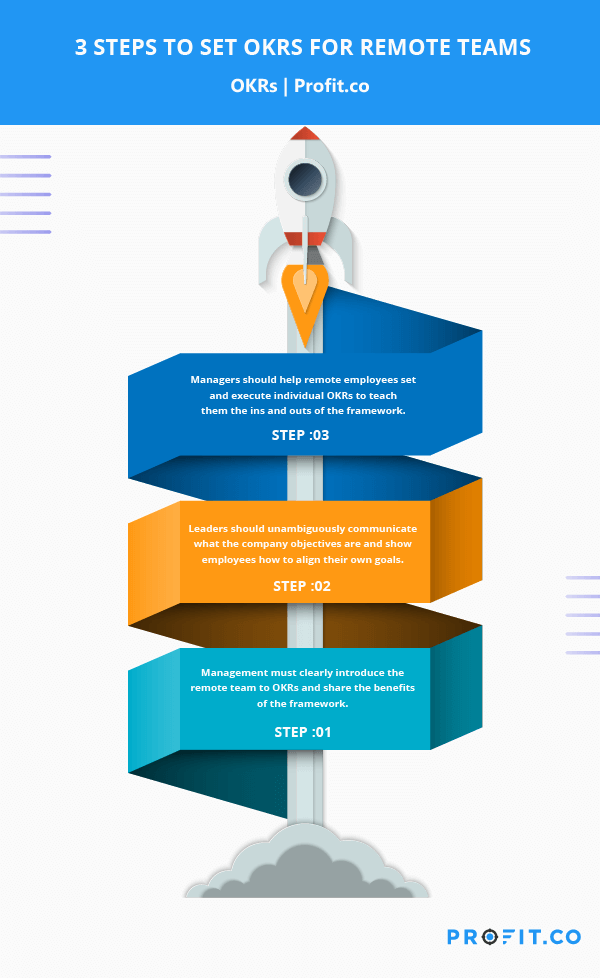The COVID-19 pandemic has changed how businesses work. Companies have had to go remote, and even over a year after the pandemic began, the fully remote or hybrid model of work is still the new normal.
While many companies have taken these changes in stride and adapted well in the circumstances, the downside of working remotely is that team members don’t know what their teammates are doing. In this sense, all employees run the risk of being left out of the loop. So managers have to check in with their team often and must communicate clearly to the members in order to manage and
improve remote performance.
Technology now allows people to connect anytime, anywhere, to anyone in the world, from almost any device. This is dramatically changing the way people work.
Setting OKRs for remote teams is a good way to ensure all employees are on the same page, there is no miscommunication, or confusion, thus making performance tracking more manageable– even during remote work.
How can setting OKRs benefit remote performance?
Setting OKRs can benefit remote performance in the following ways:
- Increases focus towards achieving goals
- Boosts productivity of the remote team
- Helps align goals
- Promotes accountability
- Creates a system for regular check-ins
- Builds trust with transparency
1. Increases focus towards achieving goals
OKRs help set clear expectations. And when there are clear expectations set, it helps remote teams prioritize tasks and use resources primarily for those high priority tasks, instead of those that are not; even though they might ‘seem’ important.
It’s easy for ambiguity to creep in while working remotely. OKRs take the guesswork out, especially in a remote scenario. and provide more clarity on what the company’s top priorities are. Employees are more motivated and engaged to give it their best effort. This concerted effort and focus helps themselves, their team, and the whole organization scale new heights.
The other benefit of focusing on high-priority tasks and desired results is that remote performance is no longer tied to work hours. Instead, it is based on result-oriented goals, where the team focuses on making progress on their goals.
2. Boosts productivity of the remote team
OKRs boost productivity levels of the remote team. Setting goals that are challenging but achievable, pushes the remote team out of their comfort zone to achieve more. The aim must be to achieve 60%-70%; meeting 100% of the objectives means that the goals need to be more challenging.
3. Helps align goals
Every employee is aware of what the company strategy and goals are and what is expected of them in actualizing those goals, but things can fall apart really fast due to lack of clarity and supervision while working remotely. OKR is the glue that holds it together and helps align goals across the company, making sure that performance does not suffer, just because the team is remote.
Senior management sets the high level OKRs and teams define their own OKRs in collaboration with their managers. Individual and team-level OKRs tie back in with the larger company level objectives. The OKR framework encourages both top-down and bottom-up alignment.
The OKR framework encourages both top-down and bottom-up alignment.
Despite the fact that goals are set on different levels, all OKRs in an organization are visible to everyone involved, because of the visibility feature in the OKR software. So irrespective of teams working remotely, they still very much collaborate and work together, thanks to OKRs.
In order to fully benefit from the transparency aspect of OKRs, you need to manage your objectives and key results on an agile and intuitive OKR software. You can get started on Profit.co today and see how our software can help you focus on your priorities, measure outcomes, and achieve more!
4. Promotes accountability
When remote employees are given all the information they need for them to achieve their goals and make their own decisions to achieve them, there is no ambiguity and everyone’s goals are aligned, working towards a collective commitment. Sharing all that information is also a display of trust, which can be incredibly motivating, especially in a remote situation where you can’t even meet in person. And if the company can get its employees motivated, there is no need for micromanaging and nobody has to worry about a lack of accountability.
Since teams set OKRs collaboratively, there is more interest and a sense of accountability for the goals they have agreed on. Weekly check-ins ensure that work, and performance, albeit remote, flows with the smoothness of a well-oiled machine.
5. Creates a system for regular check-ins
OKRs can help remote teams set up a system for their top priorities. Managers and leaders can review team performance on a regular basis using OKR check-ins. Check-in frequency can be adjusted to cater to the team’s and organization’s needs.
This allows remote teams to communicate more frequently, and seamlessly, about remote performance– how things are going, what’s going well, what needs improvement and what doesn’t need to be done at all. This keeps everyone updated on every individual employee’s progress, and reinforces the most important goals. The idea is to put goal progress at the top of everyone’s mind, giving them the freedom to work on their own schedules and in their own styles, but bringing everyone back to check-in and compare progress at the same time.
OKRs act as a great leveler among different styles of work. It’s a great way to get the best out of both introverts and extroverts and for them to share the same platform.
6. Builds trust with transparency
OKRs give a platform for remote teams to converse with each other, be transparent, and stay aligned across teams.
It’s as transparent as it gets when the dashboard feature in the OKR software makes OKRs visible to everyone in the organization, across all levels of hierarchy. Every employee has visibility into their co-workers’ OKRs, even when they’re working remotely. This cultivates teamwork across the company. Since it is so transparent, every employee is able to see how a co-worker’s or a manager’s OKR can impact their individual work.
For the managers, OKRs help remotely supervise performance and ensure work is on track, and it eliminates the need to micromanage.
Steps to set OKRs for remote teams

Following are a few steps to set OKRs for remote teams for them to benefit from it:
Step 1: Introduce the remote team to OKRs
For the OKR approach to work, it is important that everybody is in agreement. Management must clearly state to the remote team why OKRs are being introduced, including sharing the OKR payoffs or benefits, how it can boost remote performance, and how it can be used to measure success and make strategic decisions. Make sure that all questions are answered regarding OKRs.
Step 2: Communicate clearly what the company objectives are
Once everyone is on board regarding the OKR approach, the next step is to clearly communicate what the company objectives are at a high, company level, so that remote teams are aware that their individual and team goals need to be aligned with the company goals.
It’s easy to lose sight of the bigger picture while working remotely and not on site.
Here are a few questions to think about when establishing OKRs for remote teams:
- Does everyone have one big collective goal?
- Are the goals of the employees and teams in sync with the goals of the company?
- Will the team goals help the company meet its OKRs?
- Is there anything that the team members need to change about what they are working on?
Step 3: Set and execute individual OKRs in collaboration with the remote employee
It is very important that while setting OKRs for remote teams, managers do it in collaboration with the remote employee. This is especially important since the employee needs to understand how OKRs will help them with their goals and how it will contribute to teamwork and to the organization.
They need to realize that it is not just a tool to evaluate remote performance but that there’s so much more to it, and how learning about it can help them. When they are fully convinced of the benefits of OKR, they will be more willing to take risks and think outside the box, and be more accountable. 3-5 objectives are the perfect number — anything more can be too much to handle.
Final Thoughts
Setting OKRs for remote teams offers the perfect balance between performance and supervision. Transparency in the system helps with employees taking accountability and finding the motivation to achieve their goals. Communication is key; and even more important when it comes to remote performance, given the current situation for most companies. It provides context and meaning, helping employees stay focused, collaborate, and coordinate with each other to achieve their own and the company’s goals.
To learn what an OKR software can do for your organization, book a free demo with Profit.co’s OKR experts today!

